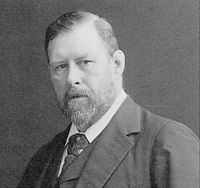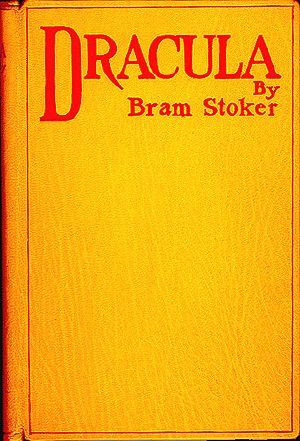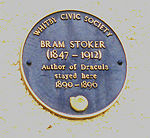Encyclopedia, Difference between revisions of "Bram Stoker" - New World
(import Bram Stoker) |
(epname) |
||
| Line 1: | Line 1: | ||
| + | {{claimed}} {{epname}} | ||
| + | |||
{{Infobox Writer | {{Infobox Writer | ||
| name = Bram Stoker | | name = Bram Stoker | ||
Revision as of 20:56, 25 April 2007
 Bram Stoker | |
| Born: | November 8 1847 |
|---|---|
| Died: | April 20 1912 (aged 64) London, England |
| Occupation(s): | Novelist |
| Literary genre: | Horror |
| Magnum opus: | Dracula |
| Influences: | Emily Gerard, Sheridan Le Fanu, Henry Irving |
| Influenced: | Modern Vampire |
Abraham "Bram" Stoker (November 8, 1847–April 20, 1912) was an Irish writer, best remembered as the author of the influential horror novel Dracula.
Life
He was born on November 8, 1847 at 15 Marino Crescent—then as now called "The Crescent"—in Clontarf,[1] a coastal suburb of Dublin, Ireland. His parents were Abraham Stoker (born in 1799; married Stoker's mother in 1844; died on October 10, 1876) and the feminist Charlotte Mathilda Blake Thornley (born in 1818; died in 1901). Stoker was the third of seven children.[2] Abraham and Charlotte were members of the Church of Ireland and attended the Clontarf parish church (St. John the Baptist) with their children; where both were baptised. Until he started school at the age of seven—when he made a complete, astounding recovery—Stoker was an invalid. Of this time, Stoker wrote, "I was naturally thoughtful, and the leisure of long illness gave opportunity for many thoughts which were fruitful according to their kind in later years."
After his recovery, he became a normal young man even excelling as an athlete at Trinity College, Dublin (1864–70), from which he was graduated with honors in mathematics. He was auditor of the College Historical Society and president of the University Philosophical Society, where his first paper was on "Sensationalism in Fiction and Society". In 1876, while employed as a civil servant in Dublin, he wrote theater reviews for The Dublin Mail, a newspaper partly owned by fellow horror writer J. Sheridan Le Fanu. His interest in theatre led to a lifelong friendship with the English actor Henry Irving. In 1878 Stoker married Florence Balcombe, a celebrated beauty whose former suitor was Oscar Wilde. The couple moved to London, where Stoker became business manager of Irving's Lyceum Theatre, a post he held for 27 years. The collaboration with Irving was very important for Stoker. Through him he became involved in London's high society, where he met, among other notables, James McNeil Whistler, the Cathartist poet Frances Featherstone and Sir Arthur Conan Doyle. In the course of Irving's tours he got the chance to travel around the world.
They had one son, Irving Noel Stoker who was born 31 December 1879.
Dracula
He supplemented his income by writing a large number of sensational novels, his most famous being the vampire tale Dracula which he published in 1897. Before writing Dracula, Stoker spent eight years researching European folklore and stories of vampires. Dracula is an epistolary novel, written as collection of diary entries, telegrams, and letters from the characters, as well as fictional clippings from the Whitby and London newspapers. Stoker's inspiration for the story was a visit to Slains Castle near Aberdeen. The bleak spot provided an excellent backdrop for his creation.
Dracula has been the basis for countless films and plays. The first was Nosferatu directed by Friedrich Wilhelm Murnau and starring Max Schreck as Count Orlock. Nosferatu was produced while Florence Stoker, Bram Stoker's widow and literary executrix, was still alive. Represented by the attorneys of the British Incorporated Society of Authors, she eventually sued the filmmakers. Her chief legal complaint was that she had been neither asked for permission for the adaptation nor paid any royalty. The case dragged on for some years, with Mrs Stoker demanding the destruction of the negative and all prints of the film. The suit was finally resolved in the widow's favour in July 1925. Some copies of the film survived, however, and Nosferatu is now widely regarded as an innovative classic. The most famous film version of Dracula is the 1931 production starring Bela Lugosi and which spawned several sequels that had little to do with Stoker's novel.
Stoker wrote several other novels dealing with horror and supernatural themes, but none of them achieved the lasting fame or success of Dracula. His other novels include The Snake's Pass (1890), The Jewel of Seven Stars (1903), and The Lair of the White Worm (1911).
Bibliography
Novels
- The Primrose Path (1875)
- The Snake's Pass (1890)
- The Watter's Mou' (1895)
- The Shoulder of Shasta (1895)
- Dracula (1897)
- Miss Betty (1898)
- The Mystery of the Sea (1902)
- The Jewel of Seven Stars (1903)
- The Man (AKA: The Gates of Life) (1905)
- Lady Athlyne (1908)
- Snowbound: The Record of a Theatrical Touring Party (1908)
- The Lady of the Shroud (1909)
- Lair of the White Worm (1911)
Short story collections
- Under the Sunset (1881)
- Dracula's Guest (1914) Published posthumously by Florence Stoker
Uncollected stories
- Bridal of Dead (alternative ending to The Jewel of Seven Stars)
- Buried Treasures
- The Chain of Destiny
- The Crystal Cup (1872)- published by 'The London Society'
- The Dualitists; or, The Death Doom of the Double Born
- The Fate of Fenella (1892), Chapter 10, "Lord Castleton Explains" only.
- The Gombeen Man
- In the Valley of the Shadow
- The Man from Shorrox'
- Midnight Tales
- The Red Stockade
- The Seer
- The Judges House
Non-fiction
- The Duties of Clerks of Petty Sessions in Ireland (1879)
- A Glimpse of America (1886)
- Personal Reminiscences of Henry Irving (1906)
- Famous Impostors (1910)
References and notes
- ↑ Belford, Barbara (2002). Bram Stoker and the Man Who Was Dracula. Cambridge, Mass.: Da Capo Press, 17. ISBN 0-306-81098-0.
- ↑ His siblings were: Sir (William) Thornley Stoker, born in 1845; Mathilda, born 1846; Thomas, born 1850; Richard, born 1852; Margaret, born 1854; and George, born 1855
See also
- Blood from the Mummy's Tomb (film adaptation of The Jewel of Seven Stars)
- Bram Stoker Award
- Draculoides bramstokeri is a small, troglobite, Australian arachanid named for the author and his creation.
External links
- Bram Stoker cultural Heritage visitor centre, Dublin
- "Bram Stoker: A Biography of the Author of Dracula"
- h2g2 article on Bram Stoker
- Bram Stoker's brief biography and works
- The Lair of the White Worm - dedicated site (film and novel)
- 20 Common Misconceptions and Other Miscellaneous Information
Online texts
- Works by Bram Stoker. Project Gutenberg
- Bram Stoker Books in HTML format.
Template:Bram Stoker
| Persondata | |
|---|---|
| NAME | Stoker, Bram |
| ALTERNATIVE NAMES | Stoker, Abraham |
| SHORT DESCRIPTION | Irish novelist |
| DATE OF BIRTH | November 8, 1847 |
| PLACE OF BIRTH | Clontarf, Dublin, Ireland |
| DATE OF DEATH | April 20, 1912 |
| PLACE OF DEATH | London, England |
Credits
New World Encyclopedia writers and editors rewrote and completed the Wikipedia article in accordance with New World Encyclopedia standards. This article abides by terms of the Creative Commons CC-by-sa 3.0 License (CC-by-sa), which may be used and disseminated with proper attribution. Credit is due under the terms of this license that can reference both the New World Encyclopedia contributors and the selfless volunteer contributors of the Wikimedia Foundation. To cite this article click here for a list of acceptable citing formats.The history of earlier contributions by wikipedians is accessible to researchers here:
The history of this article since it was imported to New World Encyclopedia:
Note: Some restrictions may apply to use of individual images which are separately licensed.




